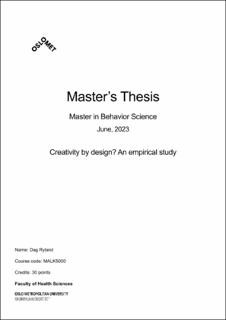| dc.description.abstract | Design thinking has become a popular method of innovation in the business world today, among others. Design thinking is a 5-step iterative process in which the end user is in focus. This human-centered approach has grown out of the Hasso Plattner Institute of Design (d.school) at Stanford University. One of the founders of the institute, David Kelley, and his brother Tom Kelley wrote the book Creative Confidence. In the book, they compare creative confidence to self-efficacy, and they name design thinking as a vessel to use to gain creative confidence. Self-efficacy is a construct presented by the famous American psychologist Albert Bandura. Due to the lack of scientific literature on creative confidence, this empirical study looks instead at creative self-efficacy. Creative self-efficacy is a more widely used construct within the literature. Self-efficacy theory is then interpreted and discussed from a behavior analytic point of view as rule-governed behavior. Kelley and Kelley’s hypothesis is investigated in this thesis: Is a Design thinking workshop an effective way to increase the participant’s creative self-efficacy? The design thinking workshop was conducted with 6 participants and the pretest-posttest 1&2-design were conducted. The results showed an increase in creative self-efficacy in all participants in the first posttest, and similar results were found weeks later, except for one participant whose score decreased. The findings are discussed from two theoretical perspectives: self-efficacy theory and behavior analysis.
Design thinking, eller designtenkning på norsk, har blitt en populær metode for innovasjon blant annet i næringslivet. Designtenkning er en 5-stegs iterativ prosess, med fokus på sluttbrukeren. Denne menneskesentrerte tilnærmingen har sitt utspring i Hasso Plattner Institute of Design (d.school) ved Stanford University. En av grunnleggerne av instituttet, David Kelley, har sammen med broren Tom Kelley skrevet boken Creative Confidence. I boken sammenligner de kreativ selvtillit med mestringstro (self-efficacy), og de nevner designtenkning som et verktøy for å oppnå kreativ selvtillit. Mestringstro er et begrep som ble presentert av den berømte amerikanske psykologen Albert Bandura. Da kreativ selvtillit ikke er et begrep med noe vitenskapelig empirisk støtte, vil denne studien heller se på konstruktet kreativ mestringstro. Kreativ mestringstro er et mer utbredt begrep i litteraturen. Teorien om mestringstro tolkes og diskuteres ut fra et atferdsanalytisk perspektiv som regelstyrt atferd. Kelley og Kelleys hypotese undersøkes i denne avhandlingen: Er en workshop i designtenkning en effektiv måte å øke deltakernes kreative mestringstro på? Workshopen om designtenkning ble gjennomført med 6 deltakere, og et pretest-posttest 1&2-design ble brukt. Resultatene viste en økning i kreativ mestringstro hos alle deltakerne i den første posttesten, og lignende resultater ble funnet flere uker senere, med unntak av én deltaker som fikk en lavere score. Funnene diskuteres ut fra to teoretiske perspektiver: mestringstro og atferdsanalyse. | en_US |
